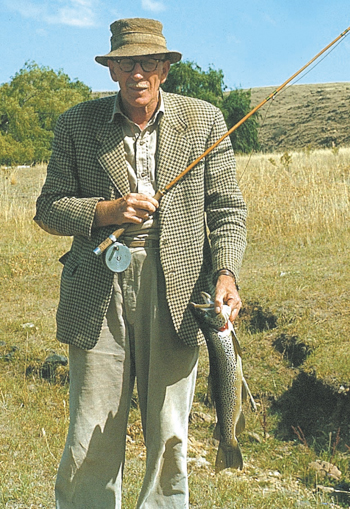Richard Henry (Dick) Wigram was born into English aristocracy in 1903. At four he caught his first fish, and at seven he received his first rod. Educated at Winchester, as a schoolboy he spent his summer holidays angling on England’s Midlands streams.
At just twenty-one he emigrated with his brother to Tasmania and lived for much of his life close to those fine streams, the South Esk and his favourite, the Macquarie. Interestingly, Wigram was related to the Wigram of Money-Wigram and Sons who in 1864 provided space on the ship carrying the precious cargo of trout ova on its first successful passage to the Antipodes.
Wigram was a leader in fly design and manufacture. At the time many anglers used big wet flies—often salmon flies and their derivatives—but Wigram was developing innovative designs and generally they were well received. “Wigram’s special patterns have proved their merit by catching many of the largest fish and heaviest bags taken by anglers during the last five years,” claimed one newspaper advertisement in February 1938. For lake fishing Wigram and his team of fly dressers were producing flies such as the Green Matuka, Yellow Peril, Lake Beetle, Black Matuka, Black Beetle and the Penstock Fly, and imitative flies, including patterns by other designers, for the rivers.
As a writer with a steady output, Wigram penned magazine articles as well as angling columns (such as his ‘Piscator’ column in the Weekly Courier), angling reports, and letters to the editor in the newspapers of the day. He completed six books, all highly valued both for their content and scarcity: Trout and Fly in Tasmania (1938), Nymph Fishing in the Southern Hemisphere (1939), Anglers Guide to Tasmania (1946 and 1959), The Uncertain Trout (1951), The Shannon Rise (1953) and The Fly (2002).
In his foreword in Trout and Fly in Tasmania Charles Harrison recommended Wigram’s new book as “a standard practical work on Tasmanian trout fishing”. It was sound advice, and Wigram’s book remained the standard work until superseded by David Scholes’ Fly Fisher in Tasmania in 1961. It was the only title with solely Australian content to gain a mention in James Robb’s Notable Angling Literature (1947).
Wigram was one of the best fly fishers of his era, an exceptional fly creator, fly tyer and one of our very best writers.

